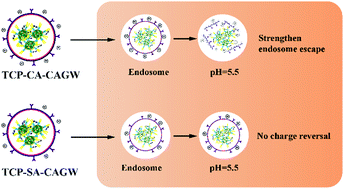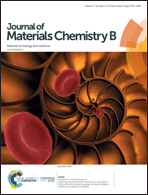Multifunctional gene delivery systems with targeting ligand CAGW and charge reversal function for enhanced angiogenesis†
Abstract
Gene delivery systems with good biocompatibility and high transfection efficiency play a major role in the clinical application of gene therapy. It is of great interest to develop a functional anionic polymer to modify polycationic carriers for the purpose of improving their biocompatibility and gene delivery ability. Herein, we prepared three kinds of anionic polymers, i.e., cis-aconitic anhydride grafted poly(L-lysine) (PLCA), cis-aconitic anhydride and CAGW functional peptide grafted poly(L-lysine) (PLCA-CAGW), and succinic anhydride and CAGW peptide grafted poly(L-lysine) (PLSA-CAGW), and coated them onto binary gene complexes to obtain three ternary complexes, i.e., TCP-CA, TCP-CA-CAGW and TCP-SA-CAGW, respectively. These gene delivery systems were integrated with a specific functional peptide and smart polyplexes that enabled them to perform a desired function in response to pH changes in biological microenvironments. The results of the cell viability assay showed that the prepared anionic polymers could improve the biocompatibility of gene complexes. Gene expression at the mRNA and protein levels demonstrated that TCP-CA-CAGW enhanced the gene delivery efficiency, benefiting from the targeting CAGW peptide and charge reversal moiety (cis-aconitic amide), while TCP-SA-CAGW showed a relatively low transfection efficiency because of negatively charged PLSA-CAGW and its non-reversal function. The PLCA-CAGW shell in TCP-CA-CAGW possessed an aconitic acid group, EC targeting ligand and charge reversal cis-aconitic amide, which enabled the gene delivery systems to be neutral in blood circulation, but once in the acidic lysosomes, they became positively charged for improving lysosomal escape and nuclear localization. Importantly, the in vitro/vivo angiogenesis assay demonstrated that human umbilical vein endothelial cells transfected with TCP-CA-CAGW functionalized ternary complexes could obviously enhance vascularization. These multifunctional ternary complexes with functional smart anionic polymer shells possessed low cytotoxicity and high gene delivery efficiency, and this strategy may be a promising platform for cardiovascular gene therapy.



 Please wait while we load your content...
Please wait while we load your content...